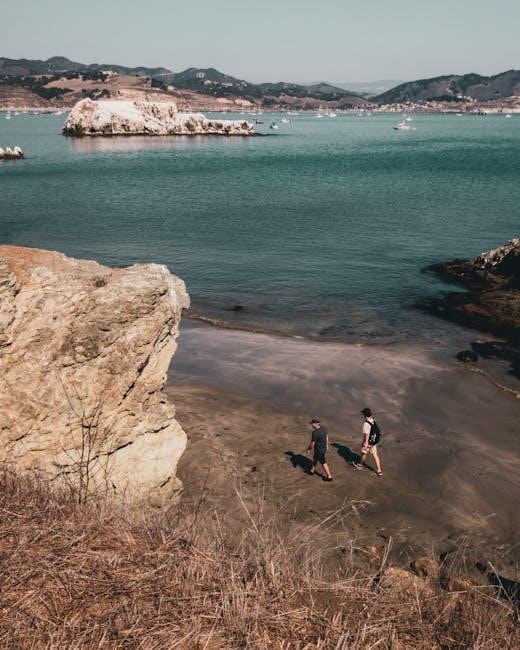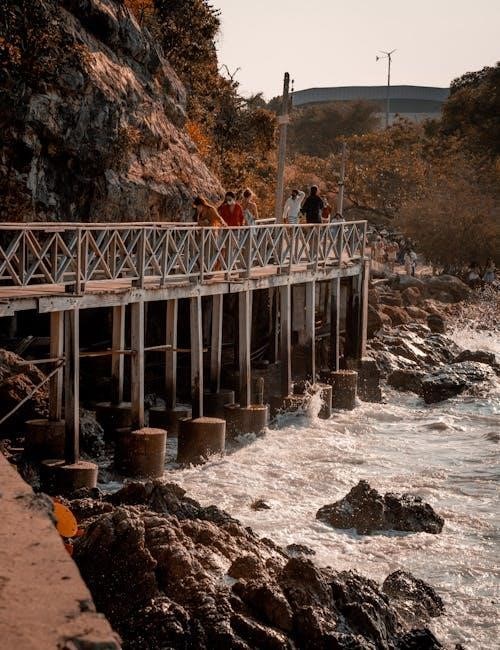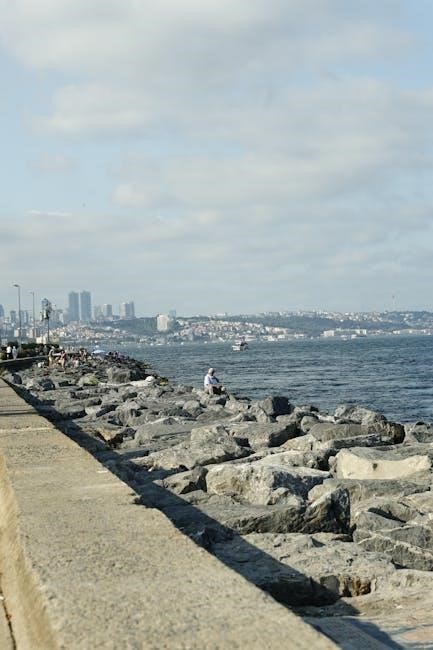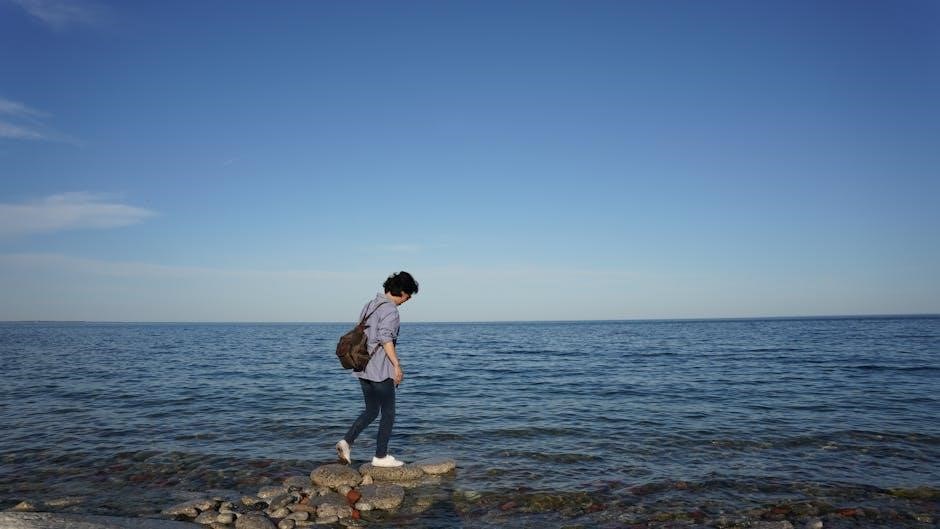Overview of the Bay of Fires Self-Guided Walk
Discover the breathtaking Bay of Fires on Tasmania’s east coast‚ known for its pristine beaches‚ orange granite boulders‚ and self-guided walking adventures.
The Bay of Fires‚ located on Tasmania’s stunning east coast‚ is a region of unparalleled natural beauty. Renowned for its pristine white-sand beaches‚ crystal-clear waters‚ and iconic orange granite boulders‚ it offers a unique and tranquil environment for outdoor enthusiasts. The area is part of Mount William National Park and is celebrated for its diverse landscapes‚ including coastal heathlands and secluded coves. Wildlife‚ such as kangaroos‚ wallabies‚ and a variety of bird species‚ thrives in this untouched setting. The region also holds significant cultural importance‚ with evidence of Indigenous heritage dating back thousands of years. Its remote and pristine nature makes it a perfect destination for those seeking an immersive and peaceful connection with Tasmania’s wilderness.
1.2 Importance of Self-Guided Walking in Tasmania
Self-guided walking in Tasmania offers unparalleled flexibility and independence‚ allowing travelers to immerse themselves in the island’s pristine landscapes at their own pace. This approach is particularly appealing in regions like the Bay of Fires‚ where the untouched natural beauty and diverse wildlife create a unique connection with nature. Self-guided walks empower individuals to tailor their experience‚ whether seeking solitude‚ photography opportunities‚ or immersive cultural encounters. Tasmania’s well-marked trails and accessible logistics make self-guided adventures feasible for walkers of all fitness levels. Additionally‚ this style of travel supports local businesses and promotes sustainable tourism‚ aligning with Tasmania’s commitment to environmental preservation. For those who value freedom and personal discovery‚ self-guided walking is a transformative way to explore Tasmania’s iconic trails and hidden gems.

Planning Your Bay of Fires Self-Guided Walk
Plan your Bay of Fires adventure by selecting the ideal duration‚ timing‚ and accommodation‚ ensuring a seamless experience exploring Tasmania’s stunning coastal trails and landscapes.
2.1 Choosing the Right Duration for Your Trip
Selecting the right duration for your Bay of Fires self-guided walk is crucial. Most walkers opt for a 3- or 4-day itinerary‚ which allows ample time to explore the region’s highlights without feeling rushed. A 3-day trip typically covers around 25-30 kilometers‚ offering a mix of coastal hiking and beach relaxation. For those seeking a more immersive experience‚ a 4-day walk provides additional opportunities to delve into remote coves‚ scenic inland trails‚ and cultural sites. It’s important to consider your fitness level and how much time you want to spend exploring versus relaxing. Shorter trips can still capture the essence of the Bay of Fires‚ but longer durations offer a deeper connection to the landscape. Plan according to your preferences and pace to ensure an enjoyable journey.
2.2 Best Time to Embark on the Walk
The ideal time for a self-guided Bay of Fires walk is between October and May‚ when mild temperatures and clear skies prevail. Spring (October to November) and summer (December to February) offer optimal conditions‚ with wildflowers blooming and wildlife active. Autumn (March to May) is also pleasant‚ with fewer crowds and comfortable hiking weather. Winter (June to September) is less suitable due to colder temperatures and potential rainfall. Plan your trip during the dry season to fully enjoy the coastal trails and scenic vistas. Book accommodations and logistics in advance‚ especially during peak seasons‚ to ensure availability. This timing ensures a memorable and enjoyable experience exploring Tasmania’s stunning coastline.
2.3 Selecting Accommodation Options
Choosing the right accommodation is crucial for a seamless self-guided Bay of Fires walk. Options range from cozy cabins and boutique lodges to campsites‚ catering to various preferences and budgets. The award-winning Bay of Fires Lodge is a popular choice‚ offering comfort and stunning views. For a more rustic experience‚ campsites near the coastline provide direct access to the trail. Many tour operators offer package deals that include pre-arranged accommodations‚ ensuring a hassle-free experience. It’s advisable to book in advance‚ especially during peak seasons from October to May. Staying near Binalong Bay or St. Helens allows easy access to the trailhead and local amenities. Accommodations often provide essential amenities like meals‚ luggage transfers‚ and detailed trail maps‚ enhancing your walking adventure. Selecting the right lodging ensures you can focus on enjoying the pristine landscapes and wildlife of the Bay of Fires.

Detailed Itinerary for the Bay of Fires Walk
Embark on a 5-day adventure‚ exploring pristine beaches‚ coastal trails‚ and scenic vistas. Each day offers a mix of hiking‚ wildlife spotting‚ and relaxation in Tasmania’s stunning landscape.
3.1 Day 1: Arrival and Initial Exploration
Your Bay of Fires adventure begins with arrival on Tasmania’s stunning East Coast. Check into your chosen accommodation‚ whether it’s the award-winning Bay of Fires Lodge or a cozy cabin near Binalong Bay. Spend the afternoon exploring the region’s iconic landmarks‚ such as the vibrant orange granite boulders and pristine white sand beaches. Take a leisurely stroll along the coastline‚ soaking in the serene atmosphere and spotting local wildlife like wallabies or seabirds. As the day unwinds‚ enjoy a peaceful evening with a gourmet meal‚ preparing for the exciting days of hiking ahead. This initial exploration sets the tone for your self-guided journey‚ allowing you to connect with the natural beauty of Tasmania’s Bay of Fires.
3.2 Day 2: Coastal Hiking and Landmarks
Embark on a scenic coastal hike‚ immersing yourself in the Bay of Fires’ iconic landscapes. Begin your day with a hearty breakfast before setting off to explore the region’s most breathtaking landmarks. The Bay of Fires Lodge Walk is a highlight‚ offering moderate trails with stunning ocean views. Marvel at the vibrant orange granite boulders contrasting with the crystal-clear waters‚ creating perfect photo opportunities. Keep an eye out for wildlife‚ including wallabies and seabirds‚ as you traverse the coastline. The 4-day walk covers 33km‚ with today’s segment focusing on coastal trails and secluded beaches. Enjoy the flexibility of self-guided exploration‚ allowing you to pause and absorb the natural beauty at your own pace. The mix of sandy beaches and coastal heathlands ensures a diverse and engaging hiking experience‚ making Day 2 a memorable part of your Bay of Fires adventure.
3.3 Day 3: Exploring Remote Beaches and Coves
Dedicate Day 3 to the serene beauty of remote beaches and hidden coves‚ where the Bay of Fires truly captivates the senses. Start your day with a refreshing breakfast‚ then set off to discover the lesser-known gems of the coastline. Wander through pristine white sand beaches‚ untouched by crowds‚ and explore secluded coves that offer tranquil retreats. Take your time to relax on the shore‚ enjoy a rejuvenating swim‚ or simply bask in the peaceful atmosphere. The self-guided nature of the walk allows you to linger at spots that resonate with you‚ capturing the essence of Tasmania’s untouched wilderness. As the day unfolds‚ keep an eye out for wildflowers blooming in the coastal heathlands and the diverse birdlife that calls this region home. Conclude your day with a well-deserved rest‚ reflecting on the natural wonders encountered.
3.4 Day 4: Inland Trails and Scenic Vistas
On Day 4‚ venture inland to explore the diverse trails and breathtaking scenic vistas that complement the coastal beauty of the Bay of Fires. Begin with a hearty breakfast before heading into the heart of Mt. William National Park or the Blue Tier Reserve‚ where well-marked trails wind through shaded forests and open heathlands. The self-guided walk allows you to pace yourself‚ taking in the panoramic views from elevated lookouts. Spot native wildlife‚ such as wallabies and echidnas‚ and enjoy the tranquility of Tasmania’s untouched wilderness. As you traverse the inland trails‚ the contrast between the coastal landscapes and the rugged interior becomes strikingly apparent. Conclude your day with a reflective moment at a scenic overlook‚ soaking in the vast‚ unspoiled beauty of the region. This day offers a unique perspective on the Bay of Fires’ diverse ecosystems and natural splendor.

Highlights of the Bay of Fires Walk
The Bay of Fires walk is renowned for its iconic beaches‚ vibrant orange granite boulders‚ and diverse wildlife‚ offering a mix of coastal charm and Tasmanian wilderness. Explore pristine white sands‚ spot whales and seabirds‚ and immerse yourself in the region’s rich cultural heritage.
4.1 Iconic Beaches and Coastal Scenery
The Bay of Fires is celebrated for its pristine white sand beaches and dramatic coastal landscapes‚ creating a visually stunning backdrop for walkers. The region’s iconic beaches‚ such as Binalong Bay and St. Helens‚ offer crystal-clear waters that contrast beautifully with the vibrant orange granite boulders‚ covered in lichen‚ that dot the shoreline. These natural formations are not only a photographer’s paradise but also a defining feature of the Bay of Fires’ unique charm. As you explore the coastline‚ the rhythmic sound of waves and the salty ocean breeze enhance the tranquility of the experience. The beaches are often deserted‚ allowing walkers to fully immerse themselves in the untouched beauty of Tasmania’s east coast. The interplay of light‚ color‚ and texture along the shore creates an ever-changing display of natural artistry‚ making the Bay of Fires a truly unforgettable destination for coastal enthusiasts.

4.2 Wildlife and Birdwatching Opportunities
The Bay of Fires is a haven for wildlife enthusiasts and birdwatchers‚ offering abundant opportunities to observe Tasmania’s diverse fauna. Along the coastal trails‚ walkers can spot native birds such as eastern rosellas and yellow-tailed black cockatoos‚ while the beaches provide a habitat for shorebirds like sandpipers and terns. The region is also home to marsupials‚ including wallabies and possums‚ which can often be seen grazing in the early morning or late afternoon. Marine life‚ such as dolphins and seals‚ occasionally appears along the coastline‚ adding to the richness of the ecosystem. The pristine environment and minimal human disturbance make the Bay of Fires an ideal location for encountering wildlife in its natural habitat‚ enhancing the walking experience with moments of connection to nature.
4.3 Historical and Cultural Significance
The Bay of Fires region holds profound historical and cultural importance‚ blending Indigenous heritage with European settlement history. The area is named for the numerous Aboriginal fires spotted by early European explorers‚ reflecting the long-standing presence of the Palawa people. For thousands of years‚ the Indigenous community thrived along this coastline‚ relying on its abundant resources and maintaining a deep spiritual connection to the land. European settlers later arrived‚ introducing farming and fishing practices that reshaped the landscape. Today‚ walkers can appreciate the region’s rich history through its well-preserved cultural sites and stories shared by local guides. The Bay of Fires Walk offers a unique opportunity to connect with this heritage‚ blending natural beauty with a deep sense of history and cultural identity.

Unique Features of the Bay of Fires
The Bay of Fires is renowned for its iconic orange granite boulders and pristine white sand beaches‚ creating a striking contrast with the crystal-clear waters of the Tasman Sea.
5.1 The Orange Granite Boulders
The Bay of Fires is distinguished by its vibrant orange granite boulders‚ which line the coast and create a dramatic contrast with the turquoise waters. These boulders‚ formed millions of years ago‚ are covered in a unique orange lichen‚ giving them their distinctive color. They serve as iconic landmarks and popular spots for photography. The boulders are not only visually striking but also provide a natural habitat for various marine life. Visitors often find themselves captivated by the way the boulders seem to glow against the pristine white sands and clear seas. This natural wonder is a key feature that makes the Bay of Fires a standout destination for hikers and photographers alike.
5.2 Pristine White Sand Beaches
The Bay of Fires is renowned for its stunning pristine white sand beaches‚ which are among the most beautiful in Tasmania. These untouched shores‚ paired with crystal-clear turquoise waters‚ create a picturesque landscape that captivates every visitor. The beaches are protected from development‚ preserving their natural charm and offering a serene environment for walkers. As you explore the coastline‚ you’ll encounter secluded coves and expansive stretches of sand‚ perfect for relaxation or reflection. The white sands contrast vividly with the orange granite boulders‚ creating a visually striking scene. These beaches are not only a haven for nature lovers but also a key attraction for photographers seeking to capture the region’s unique beauty. The pristine condition of these beaches ensures an unspoiled and immersive experience for all who visit the Bay of Fires.
Practical Information for the Walk
Plan your self-guided Bay of Fires walk with essentials like sturdy footwear‚ layered clothing‚ and water. Book accommodations in advance and check weather forecasts for a seamless experience.
6.1 Packing Essentials for the Trip
Packing wisely is crucial for a seamless Bay of Fires self-guided walk. Bring sturdy footwear‚ comfortable hiking boots‚ and layered clothing for varying weather conditions. Carry a reusable water bottle‚ snacks‚ and a lightweight backpack for daily essentials. Sunscreen‚ a hat‚ and insect repellent are must-haves for coastal protection. Include a map‚ compass‚ and GPS device or a smartphone with offline navigation apps. A first-aid kit and emergency contact details are also vital. For photography enthusiasts‚ a camera or high-quality phone camera will capture the stunning landscapes. Ensure you have adequate supplies‚ as services are limited in remote areas. Packing light yet thoroughly will enhance your enjoyment of this incredible Tasmanian adventure.
6.2 Logistics and Transportation Options
Planning logistics for your Bay of Fires self-guided walk involves arranging transportation to and from the trailheads. Many hikers start their journey in Launceston‚ where shuttle services or private transfers can be booked. Some tour operators offer transfers as part of their packages‚ ensuring a seamless experience. If driving‚ secure parking options are available near the trail’s starting points. For those preferring convenience‚ guided tours often include round-trip transportation from major towns like Launceston or St. Helens. Additionally‚ some accommodations in Binalong Bay provide shuttle services to the trail‚ adding flexibility to your plans. Organizing transportation in advance is essential‚ as public transit options are limited in this remote region. This ensures you can focus on enjoying the stunning coastal landscapes without logistical worries.
6.3 Safety Tips and Emergency Precautions
Ensuring safety is crucial for a successful Bay of Fires self-guided walk. Always carry sufficient water‚ as access to drinking water is limited along the trail. Wear appropriate clothing‚ including sturdy hiking boots‚ a hat‚ and sunscreen‚ to protect against the elements. Tasmania’s weather can be unpredictable‚ so check forecasts daily and be prepared for sudden changes. Be mindful of wildlife‚ including snakes and marine life‚ and store food securely to avoid attracting animals. Carry a map‚ compass‚ and GPS device‚ as phone reception can be unreliable in remote areas. In case of emergencies‚ carry a first-aid kit and consider renting a personal locator beacon (PLB) for added safety. Inform a trusted contact of your itinerary and expected return time. Stay alert and avoid risky behaviors‚ such as swimming in unpatrolled areas or walking too close to cliff edges. Emergency services can be reached via 000‚ but plan for self-reliance in remote sections of the trail.
6.4 Food and Water Supply Management
Managing food and water supplies is essential for a self-guided Bay of Fires walk. Carry sufficient water‚ as natural sources are limited and may require treatment. Plan meals in advance‚ opting for lightweight‚ high-energy foods that are easy to prepare. Use a cooler box for perishables if staying in accommodations with refrigeration. Refill water at designated safe sources‚ such as parks or accommodations‚ and treat it if unsure of quality. Pack snacks for energy boosts during the day. Consider food storage properly to avoid attracting wildlife. Some accommodations offer meal packages‚ while others allow cooking. Plan for all meals and snacks in advance‚ as services are sparse in remote areas. Always carry a water filter or purification tablets as a precaution. Ensure your food supply aligns with your walking schedule and duration. Check with your accommodation provider for meal options or kitchen facilities to simplify logistics. Don’t rely on purchasing food en route‚ as options are limited. For longer trips‚ consider arranging food drops or using portable cooking equipment. Proper food and water management ensures a safe and enjoyable experience.

Cultural and Historical Context
The Bay of Fires holds deep cultural significance‚ with evidence of Indigenous heritage and European exploration; The region is named after Captain Tobias Furneaux‚ who spotted numerous Aboriginal fires in 1773.
7.1 Indigenous Heritage of the Region

The Bay of Fires region has deep cultural ties to Tasmania’s Indigenous peoples‚ the Palawa. Evidence of their presence dates back thousands of years‚ with numerous shell middens and artifacts found along the coast. The area was a vital source of food and resources‚ with the ocean providing abundant seafood and the forests offering timber and bush tucker. The name “Bay of Fires” originates from Captain Tobias Furneaux‚ who observed numerous fires lit by the Aboriginal people in 1773. These fires were likely used for cooking‚ signaling‚ and land management. Today‚ visitors can gain insight into the region’s rich Indigenous heritage through guided tours and interpretive signage‚ which honor the history and traditions of the Palawa people.
The Bay of Fires self-guided walk offers an unforgettable experience‚ blending pristine beaches‚ vibrant orange boulders‚ and serene landscapes‚ allowing walkers to connect deeply with Tasmania’s natural beauty.
8.1 Final Thoughts on the Bay of Fires Walk
The Bay of Fires self-guided walk is an unforgettable journey through Tasmania’s pristine coastal landscapes‚ offering a perfect blend of adventure and tranquility. With its iconic white-sand beaches‚ vibrant orange granite boulders‚ and crystal-clear waters‚ the region captivates every sense. The flexibility of a self-guided itinerary allows walkers to immerse themselves in the natural beauty at their own pace‚ creating a deeply personal connection with the environment. Whether you’re capturing stunning photographs‚ spotting wildlife‚ or simply unwinding in serene surroundings‚ the Bay of Fires walk leaves a lasting impression. It’s a testament to Tasmania’s unique charm and a reminder of the beauty found in its untouched wilderness. This walk is not just a hike—it’s an immersive experience that lingers in your memory long after you’ve left the trail.